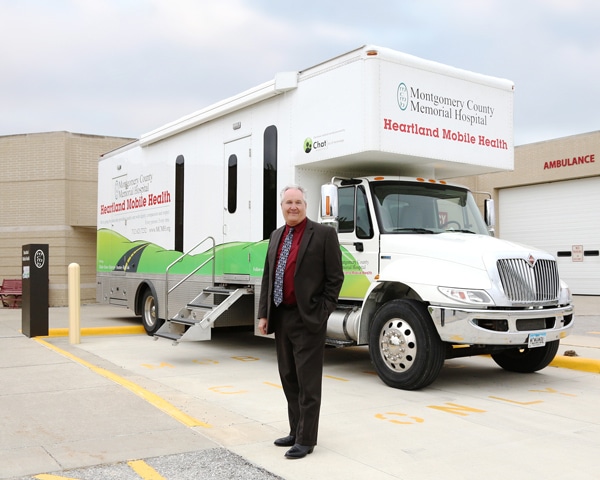Montgomery County Memorial Hospital (MCMH) serves a region with a population of only 20,000. Fewer than 350 employees, including administrative staff, work at the 25-bed facility. It meets all the conditions required to be officially considered a rural—or critical access—hospital. But its size and remote location haven’t prevented it from riding the vanguard of technology, providing patient service on par with that of much larger hospitals.
“The tech we have access to, combined with our leadership and strategic intent philosophy, puts us at the level of any urban health system,” says MCMH CIO Ron Kloewer.
Kloewer, who began his career in construction civil engineering, left the field when he grew tired of the constant travel that the role required. Born and bred in rural Iowa, he has found a way to stay close to home working for the hospital in Red Oak, Iowa. He started with the organization in 1987 when a contract project manager position opened up.
“I figured it was a good transition job,” he says. “I could get off the road, work there for two or three years, then figure out what’s next.”
But, as the saying goes, life is what happens while you’re busy making other plans. The late 1980s was the era of the PC explosion, and Kloewer, who had zero IT experience, began investigating how this new technology could help the hospital.

Kloewer told the CEO that if he would buy him a PC, some development software, and a few books to learn from, he would manage construction without a staff of secretaries and clerks.
“I told him, ‘I’ll do it all on my own, write programs and everything,’” Kloewer says. ‘“I’m going to dedicate time and effort and save you a bunch of money on labor, because this is where the future is.’”
With a $2.5 million equipment budget to outfit the new hospital, Kloewer also coordinated the move to a new facility. Quick to learn, he wrote his own databases to organize the transition. Once the project was completed, he left to work in agriculture, but soon enough, the MCMH CEO called him and asked him to come back to lead the development of health information technology.
“My engineering and construction background helped me approach health information technology from an engineering and builders’ perspective,” he says. “That means you have to start with a foundation and build from there.”
Laying that foundation prepared the hospital for all the tech advances that would come to the field beginning in the 1990s. Now, the hospital is as technically advanced as any. A major source of pride for the hospital is its Verizon Heartland Mobile Health Clinic, a clinic on wheels that uses 4G LTE technology to bring medical records anywhere the vehicle goes. The mobile clinic was front and center at the Iowa Hospital Association conference this past October in Des Moines, Iowa.
“It’s incredibly fulfilling to see people get well . . . These are my friends, neighbors, and relatives.”
The hospital also uses tech to create virtual healthcare through biometric home monitoring. MCMH gives iPads and Bluetooth-connected monitoring devices to patients with chronic conditions so the hospital can monitor their data and progress. If they need a hotspot to get online, the hospital, which has a close relationship with local ISPs, sets that up for them. The patients have constant access to their care plan, receive medication reminders, and are able to record weight and blood pressure measurements. If they aren’t tracking these things, the nurse they’ve been assigned will see that on their dashboard and check in with the patient via messaging or live one-on-one video.
“It’s a tech-driven solution to help people engage more in their own healthcare,” Kloewer says. “It’s a high level of patient engagement. The patient is participating and knows someone out there is paying attention.”
The innovations don’t stop there. The hospital recently installed a state-of-the-art, 3-D mammography unit; it’s the only hospital within fifty miles to have one. MCMH is also in the midst of putting in a sixty-four-slice CT scanner. The hospital also has an automated blood bank that does the type and crossmatch for transfusions.
All of these innovations help patients in a variety of ways. Besides the benefit they get from the technologies’ capabilities, that technology also attracts top talent to the hospital. Although a good portion of the medical staff performing primary care joins the organization locally (MCMH is the county’s largest employer), some thirty visiting specialists regularly travel from the Omaha, Nebraska metro area.
“What we try to do is create a medical environment that is modern and accepting, and in some ways advanced beyond what the larger center in the city has, so we can attract these specialists,” Kloewer says.
With all of his experience and accomplishments at the hospital over the past thirty years, Kloewer could surely find interest in his services from a larger, urban hospital. But he says that MCMH has provided him with a set of challenges that are more than sufficient. Combine that with a former farm kid getting to stay in a small-town setting that matches his sensibilities, and there’s been no reason to leave.
“It’s incredibly fulfilling to see people get well when they’re at their most vulnerable,” he says. “These are my friends, neighbors, and relatives. We do darn good work here. It’s an organization I’m proud to be a part of.”
OffSite Archiving and Disaster Recovery (DR): Serious Solutions. Serious Customer Service.
Ready for total control of your data? OffSite specializes in archiving and disaster recovery, offering real-time replication and data reconciliation.
OffSite’s vendor neutral archiving (VNA) services integrate seamlessly with other applications due to an open architecture design and industry enterprise archiving standard. This eliminates concerns about future storage requirements and obsolescence.
OffSite clients have access to vendor neutral archiving and business continuity solutions that protect their organizations’ data and ensure that they have immediate access. Thanks to the nonproprietary storage format, compatible with any DICOM environment, authorized users have multiple and alternative access channels through which they can access medical imaging and other data.
At OffSite, clients can maintain their normal operations with minimal inconvenience due to a cloud-based image management solution that takes all the challenges out of software, hardware, and maintenance, yet offers total control over the data.
OffSite Imaging Management Inc.
offsiteimagemgt.com

